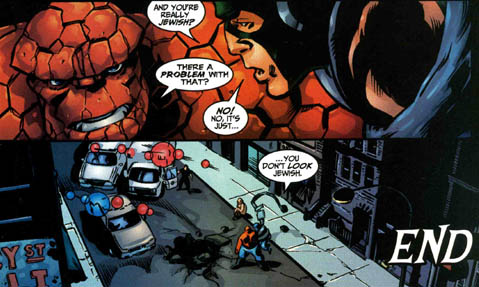
There are few things in this world about which we can be absolutely certain. However, despite the year’s many disagreements and altercations, there is one thing on which we can all agree: The “Fantastic Four” movie this past summer was absolutely, unequivocally dreadful. One could go so far as to call it fantastically awful, pun intended to full capacity. Given the successive trend of suckish adaptations of the comic book team — including the low budget 1994 Roger Corman version — I’d say the franchise is cursed, and it’s time for 20th Century Fox to wise up and hand the rights over to Disney like Sony did with “Spider-Man.”
That being said, there is one thing that the flop/bomb/dud (take your pick of synonym for a bad movie) got right in its disappointing cinematic showcase of Marvel’s answer to the Justice League, and if you blinked near the beginning, you may have missed it.
But first, a history lesson: The crime-fighting team was created by comic book legends Stanley Martin Lieber and Jacob Kurtzberg back in the early 1960s. You might know them as Stan Lee and Jack Kirby; they’re not the first men to change their names to sound less Jew-y and they won’t be the last, but I digress.
Their creation: The Fantastic Four is composed of (spoilers!!) four superheroes: Mr. Fantastic (Reed Richards), the Invisible Woman (Susan Storm), The Human Torch (Johnny Storm), and The Thing (Ben Grimm). They gained their superhuman abilities when exposed to space radiation. And, of course, none were canonically Israelites when they first appeared in 1961…
Let’s discuss Ben Grimm, shall we? He seems to have gotten the short end of the proverbial superpowered stick. While the rest of his friends got to maintain their human countenances (albeit with the ability to alter them), he turned into a giant, ugly rock monster, unable to switch back to human form. In short, he’s stuck as a sentient stone for all time. Yeah, you’d have awesome strength and the sight of you would strike fear into the hearts of your enemies, but the cons vastly outweigh the pros, making clothes shopping a nightmare. Nevertheless, everything changed for Benjamin Jacob Grimm and our knowledge of him back in the summer of 2002, when Marvel released Fantastic Four #56, or “Remembrance of Things Past.” It was then that we learned that before he became The Thing, Grimm was a poor Jewish kid, growing up on the Lower East Side of New York — a parallel to Jack Kirby, who came of age on the deli-filled streets of Delancey. As a young man, Benjy (the only name for a Jewish kid named Ben) was forced to become tough and thick-skinned, as he would literally become later on. His brother, whom he idolized, was part of a street gang, and killed because of said gang. Then his parents perished in an accident, forcing Ben to live with his aunt and uncle.
But it was in that infamous issue #56 in which Ben returns to his old stomping grounds to return a Star of David he’d stolen as a kid from a Jewish pawnshop owner. It’s a theme as old as Judaism itself: making amends, repenting for one’s sins, saying teshuva. Moreover, minds cleverer than my own have drawn comparisons between The Thing and the Jewish tale of the golem, an automaton made from earth who would protect Jews in times of great danger. Grimm also once held an all-superhero poker game to commemorate his “second bar mitzvah” — the thirteenth anniversary of becoming The Thing.
Fast forward thirteen years and two “Fantastic Four” movies, and we finally have a movie with a subtle nod to Ben’s ethnic origins. Did you see it? Are you way ahead of me? Well, you may not have even gone to the theater to see Josh Trank’s train wreck like I did, but this thoughtful nod made me squeal internally with delight (I could have done it out loud since I was about the only person in the theater). In this younger re-imagining of the team, Grimm is played by Jamie Bell, who played a badass Jewish partisan in the WWII drama “Defiance.” In this film, the Grimm family is shown as the proud (or maybe not-so-proud) owners of a junkyard.
When we meet young Benjy (played by Evan Hannemann), he’s being pushed around by his older brother as they walk into the Grimm household, passing a mezuzah on the door post! As his brother is about to get to the “clobberin’ time” part, their New York mother intervenes, as any good Jewish mother would, with the “how many times I gotta tell you?” refrain. Meanwhile, we get a fleeting glance of a golden menorah on the family’s tchotchke shelf in the background. No verbal references are made to the Grimms’ Judaism, and yet the filmmakers took enough care to include those items, keeping in line with Marvel canon.
Maybe it’s because Trank’s father, documentary filmmaker Richard Trank, and producer Simon Kinberg are both members of the tribe. Perhaps they wanted to pay homage to their shared heritage by giving the first cinematic nod to Ben Grimm’s non-superhero identity. Although the movie as a whole is basically complete dreck, it was the fleeting glimpse of those cultural objects that has stayed with me, while everything else has mostly been forgotten. While the movie that will be an iconic failure for all time, it did one Thing right, and in the most unexpected ways possible. The Thing can be viewed as an ugly rock monster, or he can be seen as a symbol of the Jewish people: proud and tough, impervious to attempts to erase their culture.
Josh Weiss is a student at Drexel University.
